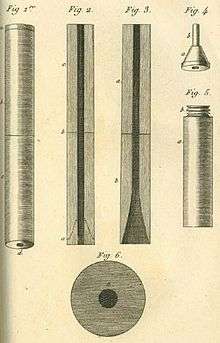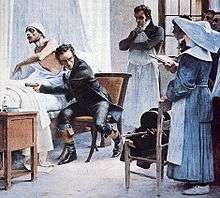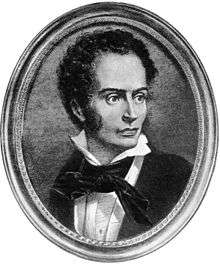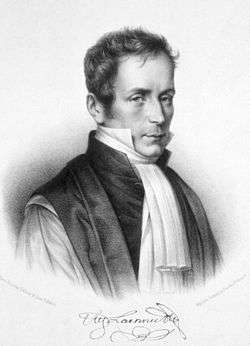René Laennec
| René Laennec | |
|---|---|
|
René Laennec | |
| Born |
17 February 1781 Quimper, France |
| Died |
13 August 1826 (aged 45) Ploaré, France |
| Citizenship | France |
| Nationality | French |
| Alma mater | University of Paris |
| Known for | Inventing the stethoscope |
René-Théophile-Hyacinthe Laennec[1] (French: [laɛnɛk]; 17 February 1781 – 13 August 1826) was a French physician. He invented the stethoscope in 1816, while working at the Hôpital Necker, and pioneered its use in diagnosing various chest conditions.
He became a lecturer at the Collège de France in 1822 and professor of medicine in 1823. His final appointments were that of Head of the Medical Clinic at the Hôpital de la Charité and Professor at the Collège de France. He died of tuberculosis in 1826 at the age of 45.
Early life and personality
Laennec was born in Quimper (Brittany). His mother died of tuberculosis when he was five years old, and he went to live with his great-uncle the Abbé Laennec (a priest). At the age of twelve, he proceeded to Nantes where his uncle, Guillaime-François Laennec, worked in the faculty of medicine at the university. Laennec was a gifted student. He learned English and German and began his medical studies under his uncle's direction.
His father (a lawyer) later discouraged him from continuing as a doctor and René then had a period of time where he took long walks in the country, danced, studied Greek and wrote poetry. However, in 1799 he returned to study. Laennec studied medicine at the University of Paris under several famous physicians, including Dupuytren and Jean-Nicolas Corvisart-Desmarets. There he was trained to use sound as a diagnostic aid. Corvisart advocated the re-introduction of percussion during the French Revolution.
Invention of the stethoscope
René Laennec wrote the classic treatise De l'Auscultation Médiate, published in August 1819.[2] The preface reads:
In 1816, I was consulted by a young woman laboring under general symptoms of diseased heart, and in whose case percussion and the application of the hand were of little avail on account of the great degree of fatness. The other method just mentioned [direct auscultation] being rendered inadmissible by the age and sex of the patient, I happened to recollect a simple and well-known fact in acoustics, ... the great distinctness with which we hear the scratch of a pin at one end of a piece of wood on applying our ear to the other. Immediately, on this suggestion, I rolled a quire of paper into a kind of cylinder and applied one end of it to the region of the heart and the other to my ear, and was not a little surprised and pleased to find that I could thereby perceive the action of the heart in a manner much more clear and distinct than I had ever been able to do by the immediate application of my ear.
Laennec had discovered that the new stethoscope was superior to the normally used method of placing the ear over the chest, particularly if the patient was overweight. A stethoscope also avoided the embarrassment of placing the ear against the chest of a woman.


Laennec is said to have seen schoolchildren playing with long, hollow sticks in the days leading up to his innovation.[3] The children held their ear to one end of the stick while the opposite end was scratched with a pin, the stick transmitted and amplified the scratch. His skill as a flautist may also have inspired him. He built his first instrument as a 25 cm by 2.5 cm hollow wooden cylinder, which he later refined to comprise three detachable parts.
His clinical work allowed him to follow chest patients from bedside to the autopsy table. He was therefore able to correlate sounds captured by his new instruments with specific pathological changes in the chest, in effect pioneering a new non-invasive diagnostic tool. Laennec was the first to classify and discuss the terms rales, rhonchi, crepitance, and egophony – terms that doctors now use on a daily basis during physical exams and diagnoses.[3] In February 1818, he presented his findings in a talk at the Académie de Médecine, later publishing his findings in 1819.
Laennec coined the phrase mediate auscultation (indirect listening), as opposed to the popular practice at the time of directly placing the ear on the chest (immediate auscultation). He named his instrument the stethoscope, from stethos (chest), and skopos (examination).
.jpg)
Not all doctors readily embraced the new stethoscope. Although the New England Journal of Medicine reported the invention of the stethoscope two years later in 1821, as late as 1885, a professor of medicine stated, "He that hath ears to hear, let him use his ears and not a stethoscope." Even the founder of the American Heart Association, L. A. Connor (1866–1950) carried a silk handkerchief with him to place on the wall of the chest for ear auscultation.[4]
Laennec often referred to the stethoscope as "the cylinder," and as he neared death only a few years later, he bequeathed his own stethoscope to his nephew, referring to it as "the greatest legacy of my life."
The modern binaural stethoscope with two ear pieces was invented in 1851 by Arthur Leared. George Cammann perfected the design of the instrument for commercial production in 1852, which has become the standard ever since.
Other medical contributions

He developed the understanding of peritonitis and cirrhosis. Although the disease of cirrhosis was known, Laennec gave cirrhosis its name, using the Greek word (kirrhos, tawny) that referred to the tawny, yellow nodules characteristic of the disease.
He coined the term melanoma and described metastases of melanoma to the lungs. In 1804, while still a medical student, he was the first person to lecture on melanoma. This lecture was subsequently published in 1805. Laennec actually used the term 'melanose,' which he derived from the Greek (mela, melan) for "black." Over the years, there were bitter exchanges between Laennec and Dupuytren, the latter objecting that there was no mention of his work in this area and his role in its discovery.
He also studied tuberculosis. Coincidentally, his nephew, Mériadec Laennec, is said to have diagnosed tuberculosis in Laennec using Laennec’s stethoscope.[3][5]
Laennec advocated objective scientific observation. Professor Benjamin Ward Richardson stated in Disciples of Aesculapius that "the true student of medicine reads Laennec's treatise on mediate auscultation and the use of the stethoscope once in two years at least as long as he is in practice. It ranks with the original work of Vesalius, Harvey and Hippocrates." [6]
Religious views
Laennec "was intensely religious and was a devout Catholic all his life".[7] He was noted as a very kind man and his charity to the poor became proverbial. Austin Flint, the 1884 president of the American Medical Association, said that "Laennec's life affords a striking instance among others disproving the vulgar error that the pursuit of science is unfavourable to religious faith." [7]
In Sir John Forbes' translation of a French biography, it is reported:
Laennec was a man of the greatest probity, habitually observant of his religious and social duties. He was a sincere Christian, and a good Catholic, adhering to his religion and his church through good report and bad report. " His death (says M. Bayle) was that of a Christian. Supported by the hope of a better life, prepared by the constant practice of virtue, he saw his end approach with composure and resignation. His religious principles, imbibed with his earliest knowledge, were strengthened by the conviction of his maturer reason. He took no pains to conceal them when they were disadvantageous to his worldly interests ; and he made no boast of them, when their avowal might have been a title to favour and advancement."— A treatise on the diseases of the chest and on mediate auscultation (1835)[8]
Legacy

- Laennec's cirrhosis refers to the appearance of regenerated liver, comprising small lobules separated by a fine, fibrous tissue; Laennec's thrombus is an antenatal thrombus in the heart
- Laennec's pearls refer to sputum produced by asthmatics.
- Hamman's murmur, also known as Laënnec–Hamman symptom, Laënnec–Müller–von Bergmann–Hamman symptom, or Hamman's crunch is a crunching sound heard over the precordium due to spontaneous mediastinal emphysema.
- At the Université Claude Bernard Lyon 1 one of the four medical schools is named after Laennec.
Laennec in fiction
A Rene Laennec appears in Rudyard Kipling's Rewards and Fairies, the second of two books where two children, Dan and Una, encounter past inhabitants of England. In the short section "Marlake Witches", set during the Napoleonic Wars, Una meets a consumptive young lady who speaks of being treated by a French doctor, a prisoner on parole, one Rene Laennec. This prisoner discusses with a local herbalist the use of 'wooden trumpets' for listening to patients' chests, much to the distrust of the local doctor. Obviously, Kipling was aware of Laennec's work and invented an English connection.
He was the subject of a 1949 French film Doctor Laennec in which he was played by Pierre Blanchar.
Laennec's landmarks in Paris
On the exterior wall of the "Hôpital Necker – Enfants Malades", where Laennec wrote Mediate auscultation, near the entrance of the hospital in 149, Rue de Sèvres, there is a marble memorial tablet with an engraved portrait of Laennec and this inscription: "Dans cet hôpital Laennec découvrit l'auscultation. 1781–1826". Some of the oldest buildings of the hospital can be seen on the same front of this large and modern medical area.
 The entrance in Rue de Sèvres
The entrance in Rue de Sèvres Laennec’s memorial tablet
Laennec’s memorial tablet One of the old buildings of the hospital
One of the old buildings of the hospital
_with_stethoscope.jpg) René-Théophile-Hyacinthe Laennec (1781–1826) with stethoscope
René-Théophile-Hyacinthe Laennec (1781–1826) with stethoscope_thesis_title_page.jpg) De l’auscultation médiate…. Paris: J.-A. Brosson et J.-S. Chaude, 1819.
De l’auscultation médiate…. Paris: J.-A. Brosson et J.-S. Chaude, 1819._Drawings_stethoscope_and_lungs.jpg) De l’auscultation médiate.... Drawings of the stethoscope and lungs.
De l’auscultation médiate.... Drawings of the stethoscope and lungs._Drawings_diseased_lungs.jpg) De l’auscultation médiate... Most of the plates in his book illustrate the diseased lung as do these four images that are consistent with lungs affected by tuberculosis.
De l’auscultation médiate... Most of the plates in his book illustrate the diseased lung as do these four images that are consistent with lungs affected by tuberculosis.
References
- ↑ While some sources use the alternative spelling Laënnec, the correct form is Laennec, without the diaraesis, which is not used in Breton names. He did not use the diaraesis in his signature.
- ↑ Laennec, R. T. H. (1819), De l’Auscultation Médiate ou Traité du Diagnostic des Maladies des Poumons et du Coeur, Paris: Brosson & Chaudé. The complete title of this book, often referred to as the "Treatise" is: De l’Auscultation Médiate ou Traité du Diagnostic des Maladies des Poumons et du Coeur (On Mediate Auscultation or Treatise on the Diagnosis of the Diseases of the Lungs and Heart).
- 1 2 3 Scherer, John R. (2007). "Before cardiac MRI: Rene Laennec (1781–1826) and the invention of the stethoscope". Cardiology Journal. 14 (5): 518–519. PMID 18651515.
- ↑ Bloch, Harry (1993). "Dr Connor's technique". Journal of Family Practice.
- ↑ Roguin, A (2006). "Rene Theophile Hyacinthe Laënnec (1781-1826): The man behind the stethoscope". Clinical medicine & research. 4 (3): 230–5. doi:10.3121/cmr.4.3.230. PMC 1570491
 . PMID 17048358.
. PMID 17048358. - ↑ CATHOLIC ENCYCLOPEDIA: Renee-Theophile-Hyacinthe Laennec. Newadvent.org. Retrieved on 14 June 2014.
- 1 2 "CATHOLIC ENCYCLOPEDIA: Renee-Theophile-Hyacinthe Laennec". Retrieved 18 August 2014.
- ↑ 'Laennec, R. T. H.; Forbes, John, Sir, A treatise on the diseases of the chest and on mediate auscultation (1835). New York : Samuel Wood & Sons ; Philadelphia : Desilver, Thomas & Co. See "XXIV Life Of The Author.
Further reading
| Wikimedia Commons has media related to René-Théophile-Hyacinthe Laennec. |
- Bon, H. (1925) Laennec (1781–1826). Dijon: Lumière
- Duffin, Jacalyn (1998) To See with a Better Eye: The Life of R.T.H. Laennec. Princeton: Princeton University Press.
- Laennec, R. T. H. (1819) De l’Auscultation Médiate ou Traité du Diagnostic des Maladies des Poumons et du Coeur. Paris: Brosson & Chaudé (The complete title of this book, often referred to as the 'Treatise' is De l’Auscultation Médiate ou Traité du Diagnostic des Maladies des Poumons et du Coeur (On Mediate Auscultation or Treatise on the Diagnosis of the Diseases of the Lungs and Heart)
- Laennec's text "De l’Auscultation Médiate..." (1819) online and analyzed on BibNum [click 'à télécharger' for English version].
- Rouxeaux, U. (1912) Laennec Paris: Baillière 1912, 1920
